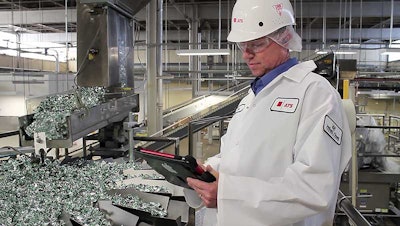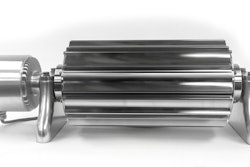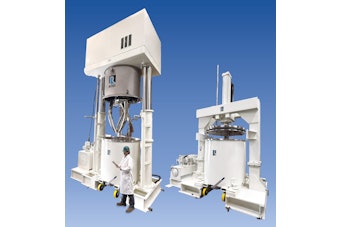Jeph Shipley, maintenance and packaging plant manager at Wixon, a manufacturer of seasonings, flavors and technologies for the food and beverage industry, thinks a lack of trained operators that fully understand how to maintain machinery is the biggest maintenance challenge facing food and beverage manufacturers today. Shipley is not alone in his thinking. The lack of qualified operators has been plaguing the food and beverage industry for decades, not just in the maintenance department, but throughout the plant floor.
Shipley addresses the staffing problem with on-the-job training, but it’s been a struggle. “We utilize the what, how and why approach to standard work instructions, so that the operators can understand the reason why it is important to follow them,” he states. Providing maintenance training, both internally and externally, is difficult, especially when you have a small team and every hour of the workday is at full capacity, he adds.
“I typically [take] the philosophy of CIL — clean, inspect, lubricate,” says Shipley. “Reactive calls for assistance reduce the effectiveness of maintenance due to taking maintenance technicians away from time that could be better spent on PMs (preventive maintenance) or improvements.”
When opportunity knocks
Meeting the changing demands of customers continue to be a challenge for food and beverage manufacturers. When addressing PM, smaller companies may not know how to best utilize their present systems to provide the required data and information for tasks. Unfortunately, there is no out-of-the-box solution. “There’s no cookie cutter. You have to tailor [your CMMS to do the] tracking of work for data analyzation,” states Shipley.
For example, maintenance planners should tailor their PM systems to be flexible so that any tasks generated during a set period can be available when changes to production schedules happen in real time. Shipley says instead of production and scheduling departments driving PM tasks, the maintenance planner should stay on top of opportunities: “Here are all the machines I need to get done in different departments. How can I get these completed? [Maintenance planners have] to work closely with department supervisors and operators, so that they’ll understand when that opportunity might happen. You really have to keep a hawk eye on it to be able to get results.”
Wixon uses a CMMS system for asset management and focuses on reliability-centered maintenance. The company tracks work order classes for trending and understanding failure modes; uses predictive maintenance tools; and targets 25 percent each week of monthly-generated PMs.
“It’s the minor stoppages that can really eat your OEE,” says Shipley. “We look at in-work order class as adjustments, breakdown, repair, PAS, production assist, and then damage, and how they relate to the effectiveness of our PMs.”
The good old-fashioned techniques of taking care of your vital equipment often yields a return on investment. But the human factor remains one of Shipley’s biggest challenges. “You can have all the bells and whistles you want, but they’re not going to do anything but drive you crazy, if [your operators and technicians] can’t operate the machine the way it’s supposed to be,” he says.
Getting help
According to Mark Hungerford, director of customer services for Leading2Lean, a food manufacturer’s focus should be on improvement rather than maintenance. This mindset of continuous improvements drives down costs and improves quality, he states: “It’s time to eliminate the maintenance department and replace it with the improvement department.”
Using a football analogy, Hungerford has four rules for winning the maintenance game using his company’s CloudDISPATCH system:
- Provide transparency and visibility for all stats.
- Work in real time with instant access to stats, and communicate in real time.
- Tools should not be a burden; mobile tools are the new standard.
- Focus on continuous improvement — 1st downs win games, not “Hail Mary” passes.
Hungerford cites West Liberty Foods as an example. In the past, the protein processor used manual work orders and had difficulty assessing its maintenance data. Downtime was not accurately captured, so it was of little or no value to technicians.
West Liberty implemented a Lean Execution System (LES) from Leading2Lean, coupled with its own mobile devices. This immediately provided value to the maintenance department, says Hungerford.
The advantages of the system are:
- Real-time access and visibility to historical data
- Access to manuals and procedures
- The right people working on the right problems at the right time
- More visibility of problems
- Information for audits is accessed electronically, including automated signatures and time stamps
West Liberty is now enjoying 89 percent workforce utilization and 95 percent companywide operational availability, and it saved $2 million in maintenance costs, according to Hungerford. Leading2Lean’s CloudDISPATCH enables real-time visibility, sustainable improvement and operations management while complementing a manufacturer’s existing ERP solutions. It also provides real-time dispatch, continuous improvement, analytics and reporting, and integrated systems in one portal.
Should you outsource maintenance?
One company that is addressing the shrinking ranks of qualified maintenance technicians and operators is ATS, a service provider of maintenance solutions. The company often recruits its staff from the military, assesses their technical abilities and creates a customized training program that enables them to address maintenance issues.
“All of our training and our technicians are circled in and around the expertise required to do maintenance,” says Mark Cox, director of technical training and advanced systems at ATS. “For example, we may do an assessment on a technician, and as part of that assessment, we’ve identified that he needs some additional training in hydraulics.”
Because food plant equipment is vastly different depending on its application and function — pneumatics, hydraulics, electronics, bearings, lubrication — various skill sets are required to maintain the wide array of machines. When applying lubricants, for example, understanding how and when to use the various grades and ratings, and what lubricants go on which machines, is knowledge not normally known by most plant staff, says Jeremy Wright, director of product management at ATS. He states that ATS hires subject matter experts in electrical, lubrication, reliability or whatever maintenance function is needed.
World-class food and beverage companies have moved away from having a maintenance technician whose role is to fix machines. “They already have their week, and maybe several weeks, out planned,” says Wright. They are focusing instead on the root causes of failures that could potentially happen to machines down the road. They are also applying more sensors and other new technologies to improve maintenance operations.
It’s a big culture shift for food and beverage companies, says Wright: “They’ve got to find a way to produce more with less investment,” so they’re being forced to look at new ways to do things. “It’s shifting more to ‘Let’s figure out exactly what’s causing that machine to fail, and let’s eliminate the root cause.’”
Wright says he recently received an update from one of ATS’ food and beverage customers after about 60 sensors had been installed. “As they’re walking through the plant, it’s continually updating a dashboard on their handhelds,” he says. “If there’s one that comes outside of the expected range, whether it be from vibration or temperature, it sends an alarm. That alarm triggers action items that need to happen, so that we do not have a catastrophic failure.”
ATS’ Factory Pro is a proprietary computer-maintenance management software system. The tool collects information, issues work orders, performs maintenance planning and scheduling, and ensures ATS has the right parts in advance to perform the required maintenance work.
When a factory signs on for services, ATS takes care of everything related to maintenance, says Wright. “We’re held accountable, and we have certain guarantees in place,” he explains. “We staff it 24/7, if that’s what is needed. Literally anything and everything related to maintenance in that facility is handled by an ATS employee.”
In many cases, the existing employees at a company are converted to ATS employees. ATS can provide a maintenance supervisor; a flight manager, who has the overall responsibility for delivering service to the plant; a planner/scheduler who uses ATS’ system for preventive and proactive maintenance activities; and in larger sites, a purchasing/procurement person who is continually buying needed parts and is trained to understand the usage of parts and what’s required to perform maintenance. Senior, midlevel and junior techs are also placed on site.
With all the new technologies available for maintenance operations, the human factor is still vital. “You need the operator and the maintenance people,” states Mike Wagner, director of the packaging segment for Rockwell Automation’s global OEM team. “You need all of these people to work together to bring expertise and knowledge and put it into the control system programmatically, so that you can then make decisions and solve problems in the control system versus waiting for somebody to manually fix the problem.”
To learn about how Rockwell Automation technology is helping OEMs put sophisticated maintenance functions into machinery, read “Helping OEMs increase uptime for food and beverage manufacturers.”






















